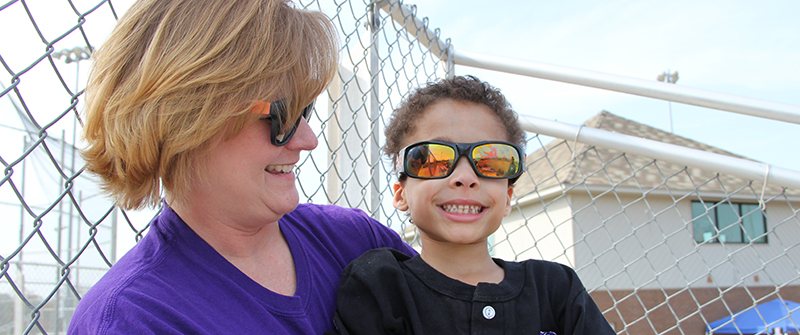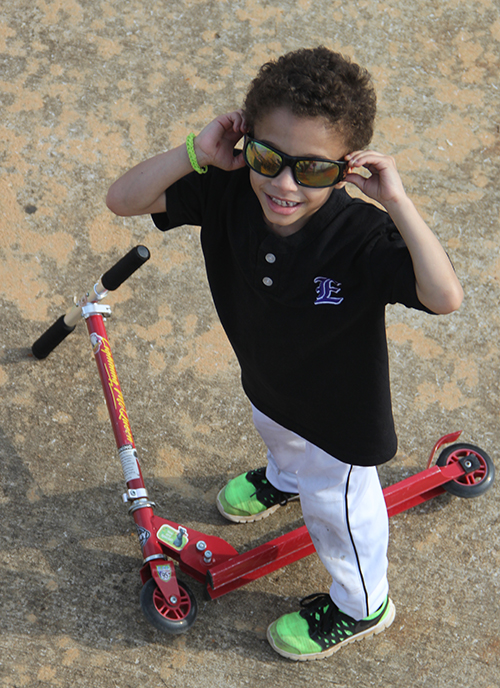Adoption process takes time, but rewards can be great
Story and photos by Lori M. Quiller

On a warm Saturday under a cloudless blue sky, the Dapprich family gathers at Gateway Park in Montgomery for a double-header afternoon of baseball.
The family patriarch, Darrell, is coaching the Saints, dressed in purple and white, while his son, Christian, 16, takes the field. The rest of the Dapprich family sits cheering in the stands. The crack of the bat brings cheers from the bleachers from everyone…except the newest member of the Dapprich family.
Six-year-old Josh is a bundle of energy. Baseball moves too slowly for him, and he doesn’t sit still very long. He grabs his sunglasses, flashes a Hollywood grin over his shoulder, and then jumps down the steps. Josh has soon commandeered his Razor scooter and is zipping in and around the bleachers. Carefree and giggling.

“Baseball isn’t exactly his thing,” Julie Dapprich says. “He’s more into basketball. Since he’s been with us, he’s turned our house into a basketball court!”
The Dapprich family grew by one in early December 2013 when Josh officially came to live with them, and his adoption was finalized in May. But, the process began more than two years ago at Orphan Day at the family’s church.
Julie and Darrell were already parents to three teenagers, twins Christian and Ashley, 16, and Emily Grace, 14. The family felt the need to do more when the opportunity presented itself. They knew the process would not be an easy one, that it would take time, but they also knew that the reward would be great.
“I was adopted,” Julie says. “So, I feel like I could understand Josh’s struggle a little better. When we had Orphan Day at the church, we took a look at the paperwork and the website, and we just knew. We knew what was right for our family.”
The family found a child on Heart Gallery of Alabama, which works closely with Alabama DHR and Alabama Pre/Post Adoption Connections to allow prospective adoptive and foster families to get to know the thousands of children in Alabama’s foster care system that who are awaiting adoption.
Alabama Pre/Post Adoption Connections is a statewide program of Children’s Aid Society, funded by Alabama DHR, designed to empower adoptive families by facilitating stronger bonds and interaction with all adoptive families. Children’s Aid Society is a 100-year-old non-profit social services agency that developed the APAC program in collaboration with the Alabama Department of Human Resources in 2001. The APAC program has offices in Birmingham, Huntsville, Montgomery and Mobile to serve adoptive families around the state.
According to Leslie Hales, LCSW, PIP, APAC pre-adoption services coordinator, the Heart Gallery of Alabama is often a prospective parent’s first introduction into the world of adoption.
Heart Gallery Alabama recruits professional photographers to take portraits of each child, as well as short videos to introduce prospective families to the children. The portraits are placed on display in a variety of venues across the state where prospective adoptive parents can learn more about the children in Alabama who are still waiting for their forever family.
That’s just a starting point. As the Dapprich family came to realize, sometimes you have to start over.
“If you find a child on the Heart Gallery website, you would go through an APAC orientation, fill out some paperwork so the screening process can begin. Sometimes the child you choose on the website may not be the child for you,” Hales says. “We process you as a potential family not just for the child you choose but for every child in the database. You may not match with the child you choose online, but you may be a better match for another child.”
Part of the qualification process for an adoptive family through APAC is a 10-week Group Preparation and Selection course that gives the family an inside look into the world of a child that who has lived in foster care and what it will be like to parent that child. In Alabama, this course is mandated if you are planning to adopt a child.
Getting to know each other
 During the course of the 10 weeks, the families get to know one another, bond with each other as they get placed with children, and network as a tightly knit group that often reaches beyond the borders of the classroom andfar after the class ends.
During the course of the 10 weeks, the families get to know one another, bond with each other as they get placed with children, and network as a tightly knit group that often reaches beyond the borders of the classroom andfar after the class ends.
Julie said that two of the most remarkable aspects of the adoption process were the classes and how involved APAC has remained with the family after the adoption.
“Every time I get a package in the mail from Children’s Aid Society, it’s exactly what I need!” Julie says. “I just got a package of books last week with some books and ideas on coping with a 6-year old. He’s such a blessing to our family, but we do have our challenges, and I’ve been amazed at just how closely our contacts with Children’s Aid have been with us not only through the process but now that the process is over. We all know that we can call on them for just about anything. APAC has social workers, counselors and psychologists to work with us on any issue that can come up after the adoption, and knowing that we can call on them at any time has been a great comfort.”
One concern the Dapprich family had early on was how bringing a rambunctious 6-year-old child into the family would affect a family dynamic that included three teenagers.
“Of course we talked about it as a family, but what impressed us the most was how the APAC representatives handled it. There’s a questionnaire that you have to fill out in the very beginning to express what you’re looking for with the adoption or foster child. The APAC reps never neglected our kids. They always ask us how they are doing, especially now that Josh is with us. It was an adjustment. It was an adjustment for all of us. But, to know that APAC not only looks out for the children that are going through the adoption but also the children that are already inside the home speaks to where their hearts are. They care so deeply about the welfare of all our kids, and that means so much to us.”
According to Hales, individuals or married couples in Alabama are eligible for adoption. APAC looks at a prospective parents’ support system because neither the adoption process nor parenting a foster child will be easy.
“We want to make sure that your support group network is going to be there for you when you adopt this child. Married or single, you need that support when you’re going through the adoption process and then afterward when you have a child, because there are going to be trials just like with any other child,” Hales says. “We call them ‘Waiting Children’ when their parental rights have been terminated and they are in foster care. It doesn’t matter the age of the child, everyone wants forever.”
An estimated 5,000 children are in foster care
At any given time, the number of children in foster care in Alabama varies, and children enter care at varying rates because of abuse and/or neglect in their home, says Connie Chance Rogers, LBSW, program supervisor of recruitment and retention of the Office of Permanency for the Alabama Department of Human Resources. Rogers estimates 5,000 children are currently in foster care.
“Right now we have 260 children whose parents’ rights have been terminated…but they will not be adopted by their current foster parents. About 90% of the children who are adopted from foster care every year are adopted by the foster parent already caring for them. At any given time a few dozen of these children may be matched with a potential family, but the official placement hasn’t occurred. Some of these children may have severe mental health issues and are in treatment facilities, so we don’t recruit for families for them until they are stable and ready for placement. Over the last several years the population of children in care has dropped due in large part to the successes our agency has realized in adoption,” Rogers says. In 2013, Alabama finalized 526 adoptions, which has decreased slightly each year since 2009 when Alabama finalized 676 adoptions.
Alabama DHR charges no fees. However, there are legal fees and court costs associated with adopting a child. If the family is adopting a child that meets the DHR special needs definition, Alabama DHR can reimburse the family up to $1,000 per child for these fees. Special needs children qualify for monthly adoption assistance payments (better known as subsidy). These children also are eligible for Medicaid coverage. There are no fees associated with adopting through DHR, and the office can also help an adopting family apply for health insurance and even pay for the child’s physical. Adopting a child may have its challenges, but DHR has many resources available to help families cope and thrive during the process.
For Josh and the Dapprich family, things are beginning to settle down and settle in. The family recently took a trip to Tuscaloosa for another double-header baseball tournament. Exhausted, Josh fell asleep on the ride home. Every now and again, the family gets a peek into just exactly what he’s really thinking.
“We put him on our bed when we got home, and he stretched out, put his hands behind his head and said, ‘Ahhhhh…I’m home.’” Julie says.
For more information on Heart Gallery Alabama, go to www.heartgalleryalabama.com. To learn more about adopting one of Alabama’s Waiting Children, visit www.childrensaid.org or www.dhr.alabama.gov and click on “Quick Links” to go to Adoptions & Alabama’s Waiting Children.




